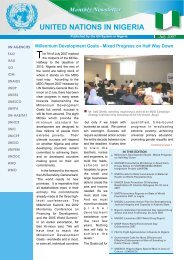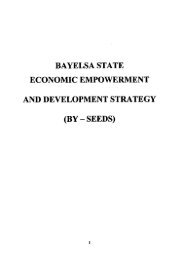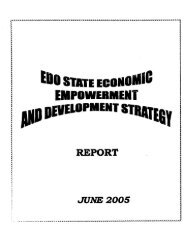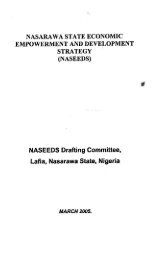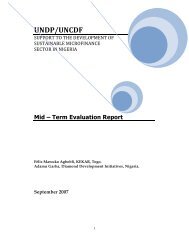Niger Delta Human Development Report - UNDP Nigeria - United ...
Niger Delta Human Development Report - UNDP Nigeria - United ...
Niger Delta Human Development Report - UNDP Nigeria - United ...
Create successful ePaper yourself
Turn your PDF publications into a flip-book with our unique Google optimized e-Paper software.
• Political participation and decision-making power, as measured by women’s<br />
and men’s percentage shares of parliamentary seats.<br />
• Economic participation and decision-making power, as measured by two<br />
indicators—women’s and men’s percentage shares of positions as legislators,<br />
senior officials and mangers, and women’s and men’s percentage shares of<br />
professional and technical positions.<br />
• Power over economic resources, as measured by women’s and men’s estimated<br />
earned income (PPP US$).<br />
For each of these three dimensions, an equally distributed equivalent percentage<br />
(EDEP) is calculated, as a population weighted average, according to the following<br />
general formula:<br />
EDEP = {[female population share (female index 1-ª )] + [male population share<br />
(male index 1-ª )]} 1/1-ª<br />
ªmeasures the aversion to inequality. In the GEM (as in the GDI) ª = 2 which places<br />
a moderate penalty on inequality. The formula is thus:<br />
EDEP = {[female population share (female index -1 )] + [male population share<br />
(male index -1 )]} -1<br />
For political and economic participation and decision-making, the EDEP is then<br />
indexed by dividing it by 50. The rationale for this indexation: In an ideal society, with<br />
equal empowerment of the sexes, the GEM variables would equal 50% - that is,<br />
women’s share would equal men’s share for each variable.<br />
Finally, the GEM is calculated as a simple average of the three indexed EDEPs.<br />
Female and Male Earned Income<br />
Despite the importance of having gender-disaggregated data on income, direct<br />
measures are unavailable. For this report crude estimates of female and male earned<br />
income have therefore been derived.<br />
Income can be seen in two ways: as a resource for consumption and as earnings by<br />
individuals. This measure is difficult to disaggregate between men and women because<br />
they share resources within a family unit. By contrast, earnings are separable because<br />
different members of a family tend to have separate earned incomes.<br />
The income measure used in the GDI and the GEM indicates a person’s capacity to<br />
earn income. It is used in the GDI to capture the disparities between men and<br />
women in command over resources and in the GEM to capture women’s economic<br />
independence.<br />
Female and male earned incomes (PPP US$) are estimated using the following<br />
data:<br />
• Ratio of the female non-agricultural wage to the male non-agricultural wage.<br />
• Male and female shares of the economically active population.<br />
• Total female and male population.<br />
• GDP per capita (PPP US$).<br />
218 NIGER DELTA HUMAN DEVELOPMENT REPORT



